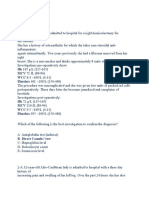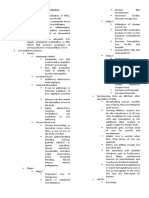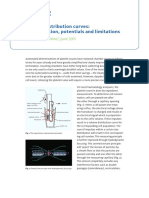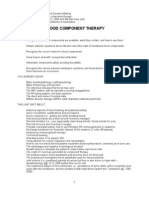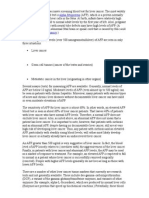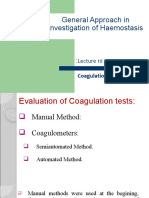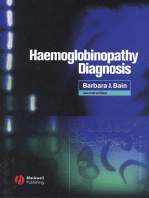Acute Promyelocytic Leukemia
Acute Promyelocytic Leukemia
Uploaded by
Kartthik ShanmugamCopyright:
Available Formats
Acute Promyelocytic Leukemia
Acute Promyelocytic Leukemia
Uploaded by
Kartthik ShanmugamCopyright
Available Formats
Share this document
Did you find this document useful?
Is this content inappropriate?
Copyright:
Available Formats
Acute Promyelocytic Leukemia
Acute Promyelocytic Leukemia
Uploaded by
Kartthik ShanmugamCopyright:
Available Formats
Acute Promyelocytic Leukemia
Treatment
Deepesh Lad
Prof S. Varma
22
nd
March 2012
1957: 6
th
Euro Congress Jaques Caen
fibrinolytic syndrome (Acquired fibrinogenopenia)
1973: Anthracyclines Bernard et al
1976: FAB classification M3 Bennett et al
1976-84: t(15,17) Golomb, Rowley & Larson
1982: microgranular variant McKenna et al
1986: Maintenance 6-MP and MTX Kantarjian et al
1988: CR=75%, early mortality=15%, resistance=10%, RR=35%
Cure=25%
Pre ATRA Period (1957-1988)
ATRA period (1988-1993)
1978: Leo Sachs; concept of differentiation, first culture system
1981: Breitman: showed terminal diff in HL-60 cell lines and APL pts
1988: Dalton: human myeloid leukemia HL-60 cell line, 100 agents were
listed for differentiation (Anthracyclines, Ara-C, RA)
1986-90: Chomienne: primary cultures of malignant cells from APL pts BM,
Etretinate not effective,
ATRA 10 times potent than other 13-cis retinoids.
Only Etretinate was available in EU and 13-cis RA in USA
Eastern philosophy meets
Western medical science
Confucius famous saying: If you use laws to direct the people, and
punishments to control them, they will merely try to evade the
laws, and will have no sense of shame. But if by virtue you guide
them, and by the rites you control them, there will be a sense of
shame and of right.
if cancer cells are considered elements with bad social behavior in
our body, educating rather than killing these elements might
represent a much better solution
1985: Meeting of Wang Zhen Yi, Shanghai Institute of Haematology
& Laurent Degos, Institute of Haematology of the Saint Louis
Hospital Paris (Thanks to Air France)
diff using low dose Ara-C in France and HHG in shanghai
ATRA was approved by Shanghai Municipality for psoriasis and Acne
1987: ATRA first used at Rui-Jin hospital,
Shanghai
First pt was a 5 year girl
1988: first paper: Huang et al, 23/24
CR=95%
Western pharma companies refused to
manufacture ATRA
So chinese students carried it to France.
1989: Chinese revolution, French laws
prohibited co-operation with China
L Degos asked Roche France: make ATRA
Paper at Memor Sloan Kettering Center
Raymond Warrell and Loretta Itri (VP
Roche Nutley, USA)
1990: Castaigne et al. Chomienne et al
(Blood), Editorial by Wiernek
ATRA trials (1990-93)
CR=95%
Relapse= 5 month (cytoP450 metabolism- accelerated clearance)
1992: Fenaux et al: ATRA+ Dauno/Ara-C reduced relapses
1991: APL 91 trial (first RCT) Dauno+ Ara-C vs ATRA f/b Chemo
stopped prematurely, EFS better in ATRA arm (79 vs 50%)
5 yr DFS (69 vs 29%)
1992: any treatment without ATRA was unethical (US and EU)
1993: APL 93: ATRA f/b Chemo vs concurrent ATRA + chemo (results
in favor of simultaneous Rx), favored ATRA maintenance
Results confirmed by US Intergroup trial
1993: APL curable disease (cure=75%)
ATRA studies
Conclusions
ATRA/ CT concurrent superior to CT or ATRA alone
Consolidation: 3 monthly courses of anthracycline based CT (+- HIDAC)
Maintenance Rx: 6-MP+MTX+ ATRA
PML-RARa for MRD assessment
Euro APL
GIMEMA
PETHEMA
JALSG
US inter group
ATRA/DA
ATRA/IDA
Maintenance
No ARA-C
2000 German 51 92 88 High-dose Ara-C GAMLCG37
Arsenic for APL (Chinese story)
1992: Sun et al (Harbin Medical Univ)
reported effect of Ailing-1 (1%
ATO+HgCl2) CR=65%
1996: Chen et al, CR in 9/10 relapsed
APL
1998: Soignet et al, clinical effect
confirmed at MSKCC
Harbin series CR=73% in Rx Nave
SIH series CR=90%
Huang et al oral composite Realgar-
indigo naturalis tablets, CR=96.7%
Single agent ATO studies
Long term sequelae of ATRA +CT
Extramedullary relapse
Second malignancies/ MDS
Cardiomyopathy (reversible cardiac dysfunction with ATRA)
ATO is the single most active agent in APL
Indian study: Mathews et al
WBC<5000, plt>20000, 100% 5yr survival with ATO
High risk pts, EFS=67%
Risk stratification
WBC Plt
Good <5000 >20000
Inter <5000 <20000
High >5000 <20000
Tallman et al. Hematology 2008
ATO in relapsed APL
ATRA + ATO
Historical model
Ablain J and Hugues de The. Blood 2011
Revised model
Ablain J and Hugues de The. Blood 2011
System biology model Ablain J and Hugues de The. Blood 2011
Hughues de the. Nat Rev 2010
ATO+ATRA studies
SIH
MDACC
Shen et al
20 90.0 ATO
20 95.0 ATRA
21 95.2 ATO+ATRA
ATRA +ATO vs ATO alone: Meta-analysis
ATO/ATRA increases CR, shortened time to CR, improved molecular remission after
consolidation and 1 yr DFS
No difference in terms of early death and main adverse events
Wang et al. Leuk Res 2011
Recommendations
European LeukemiaNet. Blood 2009
Induction therapy
Clincial trials if anthracyclins are CI
No difference between Dauno vs Idarubicin (better in younger)
Ara-C ?role, no diff in CR, OS. decreased relapse, increased death
If in doubt about CR, repeat BM after 2-3 weeks while pt is on ATRA. There are no cases of resistant ATRA and
virtually all cases of PML-RARa proven APL achieve CR
How we treat:
ATRA 25mg/m
2
+ ATO 0.15mg/kg (5days/week) x 4-6 weeks
BM after achieving normal hemogram (4-6 weeks)
Consolidation therapy
Therapeutic milestone
No role in CR1
Persistent MRD: (0.4-7% )Candidates for AlloSCT or experimental therapy ATO, Gemtuzumab, Autologous
How we treat: 3 cycles
ATRA 25mg/m
2
+ ATO 0.15mg/kg (5days/week) x 4-6 weeks (total 28 inj ATO)
ATRA 45mg/m
2
High risk WBC>30000, M3V
RTPCR PML-RARa at end of consolidation
Management after consolidation
2 studies for and 2 against
CNS most common site of extramedullary relapse
Postpone CNS prophylaxis until CR, LP is induction is hazardous
IC bleeds have more CNS relapses
Maintenance Rx: intermittent ATRA+ 6-MP+MTX for min 2 years until further studies
How we treat: 2 years,
ATRA 45mg/m
2
15 days/ 3 months
6MP 75mg/m
2
OD
MTX 20mg/m
2
weekly
RTPCR PML-RARa yearly
AIDA0493 protocol GIMEMA, AIEOP, and EORTC Blood. 2011
Grimwade et al.
A positive RT-PCR reading at the end of induction therapy was significantly associated on a
multivariate analysis with an increased risk of relapse (RR=4.9; P-value=0.034).
None of the good risk patients who were RT-PCR negative at the end of induction relapsed.
Majority of the relapses (91%) happened within three years of completion of treatment.
Post achievement of molecular remission the current MRD monitoring strategy was able to
predict relapse in 60% of cases with an overall sensitivity and specificity of 60% and 93.2%
respectively.
David Grimwade Martin Tallman
5% relapse rate versus 12% at 3 years,
associated with improved survival at a cost
of 4700 per quality adjusted life year
use of molecular monitoring to guide
treatment of relapse and inform transplant
choice has been adopted in the
International APL treatment guidelines
marginal benefit for sequential MRD
monitoring in low risk group (1% survival
benefit at 5 years, at a cost of 14,300/
QALY
High risk, relapse risk exceeds 10% and
therefore there is a much greater benefit
for MRD monitoring (10% survival benefit
at 5 years at a cost of 1350/QALY
achieve further refinement of
management, allowing development of
individualized therapy that minimizes
toxicity without compromising disease cure
with such remarkably effective therapy
even among high-risk patients, are
there subgroups which can be identified
for whom molecular monitoring for
MRD is most valuable?
Although it can be done, how
important is it to detect relapse early,
particularly in the ATO era?
Serious doubts can be raised about the
value of molecular monitoring among
patients with low- and intermediate-
risk disease if they are treated with
contemporary strategies and followed
with routine complete blood counts
Molecular monitoring in APL may, in
fact, have become less important for
the majority of patients as therapeutic
strategies have evolved with less MRD
to detect.
Special situations
Mortality rate 19% vs1% in CR
Pseudotumor cerebri in children, Rx LP, discont ATRA, acetozolamide, Prednisone 2mg/kg x 2 weeks
Genetic variants: ATRA resistant (STAT5b-RARa, PLZF-RARA) AML like approaches
ATRA sensitive (NuMA-RARa, NPM1-RARA, FIPL1-RARa)
tAPL: Rx as denovo Apl, Anthracycline use limited
Pregnancy
Relapse management
CR rates with ATO / ATRA+ CT=80-90%
ATO 25day courses x 2-4 + 4 weekly courses of ITM
Before Autologous: HIDAC mobilizing agent + CNS cover
Autologous SCT
Kharfan Dabaja et al, Biol BMT 2007
Autologous SCT
Allogeneic SCT
Allogeneic SCT
Kharfan Dabaja et al, Biol BMT 2007
Diagnosis and supportive care
Renal failure or respiratory distress requiring ICU
WH if QT >500msec, restart when <460msec
ATRA started in ER
Differentiation syndrome
Diagnosis requires vigilance and
anticipation
s/s: cough, SOB, unexplained
fever/hypotension, wt gain, edema,
ARF, CCF
CXR: Interstitial pulmonary
infiltrates/pleuro-pericardial
effusion
dd: fluid overload, DAH,
pneumonia
Persistent cytokine activity,
activation of endothelium, ICAM1,
VCAM1- tumor cell adhesion
ATRA stimulates chemokine
production
Dexa 10mg IV BD at earliest s/s.
Discontinue ATRA/ATO only in
severe cases viz renal failure/
respiratory distress requiring
admission to ICU or if non
response to dexa
Dexa until disappearance of all s/s
Presumptive therapy can be given
in high risk pts, WBC>30000-
50000
No evidence of morbidity or
mortality benefit
Coagulopathy
High risk for bleeds
WBC>10000
Fibrinogen<10g/l
Raised creatinine
PS>2
Platelet counts dont predict
Risk for thrombosis
WBC>10000, M3V
CD2,bcr3, PML RARa short
isoform, FLT3-ITD
CBC/ coagulogram twice a day
Platelet target>30000-50000
Fibrinogen target > 150mg/dl
Targets reached in only 71 and
40% on day of bleeding
Risk of bleeding till 20 days
Risk of thrombosis: Heparin only if
DVT develops
Avoid CVC
No Lumbar puncture
No leukapheresis for
hyperleukocytosis
No benefit of antifibrinolytics
Breen KA. BJH 2011
Main driver of bleeding is not aberrant TF
expression but 1
0
fibrinolytic activation
hyperfibrinolysis
CP Cancer procoagulant activates factor X and
II
Most imp fibrinolytic activator Annexin A2
IL1/TNFa downregulation of thrombomodulin
and upregulation of TF
ATRA reduces CP, TF and AnnexinA2
Haematologica 2012
You might also like
- 02 PTW Risk AssessmentDocument5 pages02 PTW Risk Assessmenttoocoolforamailid100% (1)
- Acute Leukaemia-Update: DR Niranjan N. RathodDocument89 pagesAcute Leukaemia-Update: DR Niranjan N. RathodratanNo ratings yet
- CytochemistryDocument55 pagesCytochemistrySaad Zafar Awan100% (1)
- Troubleshooting in CXMDocument3 pagesTroubleshooting in CXMquerokeropi100% (1)
- 17 Habbatus Sauda BenefitsDocument7 pages17 Habbatus Sauda BenefitsDins PutrajayaNo ratings yet
- Philippine Childhood Immunization Schedule 2019Document8 pagesPhilippine Childhood Immunization Schedule 2019Linius Cruz67% (3)
- HemoglobinopatiDocument40 pagesHemoglobinopatiHenni Junita Siregar SorminNo ratings yet
- Laboratory Testing For Cryoglobulins: Test of The MonthDocument3 pagesLaboratory Testing For Cryoglobulins: Test of The MonthDAWOODNo ratings yet
- DNB Immunohematology and Blood Transfusion Paper1Document2 pagesDNB Immunohematology and Blood Transfusion Paper1Dr.vidyaNo ratings yet
- MDSDocument46 pagesMDSFesti Mada HelmiNo ratings yet
- SPEAKER: Dr. Subhajit Das MODERATOR: Prof. Jyoti ShuklaDocument25 pagesSPEAKER: Dr. Subhajit Das MODERATOR: Prof. Jyoti Shuklaswaraj sharma100% (2)
- Compatibility Testing: Week 5Document33 pagesCompatibility Testing: Week 5Bridgette100% (1)
- Platelet IndicesDocument17 pagesPlatelet IndicesNarendra Bhattarai50% (2)
- September 2018: Frcpath Questions Hemato-OncologyDocument24 pagesSeptember 2018: Frcpath Questions Hemato-OncologySyed Danish Ali100% (1)
- Hodgkin's DiseaseDocument58 pagesHodgkin's Diseasealibayaty1No ratings yet
- Haematology Paper 1 Past PapersDocument15 pagesHaematology Paper 1 Past PapersRupinderNo ratings yet
- Pathology AIIMSDocument26 pagesPathology AIIMSvkNo ratings yet
- Interpretation of Peripheral SmearDocument34 pagesInterpretation of Peripheral Smearswathi bs100% (1)
- Lab HemostasisDocument29 pagesLab HemostasisTingLi Lucia Lorigiano100% (2)
- Hemat.Q - 1Document27 pagesHemat.Q - 1aliaaNo ratings yet
- Staph and Strep SummaryDocument24 pagesStaph and Strep SummaryJihrus Mendoza100% (1)
- Immature GranulocytesDocument10 pagesImmature Granulocytespieterinpretoria391No ratings yet
- G8 B-Thall Chromatogram Interpretation Guide1Document58 pagesG8 B-Thall Chromatogram Interpretation Guide1Kwok Hoi ShanNo ratings yet
- Hematology Case StudyDocument14 pagesHematology Case StudyDiego GarciaNo ratings yet
- Clinical Manifestations and Diagnosis of The Thalassemias - UpToDateDocument52 pagesClinical Manifestations and Diagnosis of The Thalassemias - UpToDatesushi37No ratings yet
- Plasmodium KnowlesiDocument21 pagesPlasmodium KnowlesiStanley S100% (1)
- CBC Part 3 - RBC Morphology & PlateletsDocument67 pagesCBC Part 3 - RBC Morphology & PlateletsTshwarelo LegodiNo ratings yet
- SEMINAR 3 Neoplastic, Myeloproliferative and Myelodysplastic DisordersDocument6 pagesSEMINAR 3 Neoplastic, Myeloproliferative and Myelodysplastic DisordersMICHELLE RAPELONo ratings yet
- Disorders of Iron Kinetics and Heme MetabolismDocument12 pagesDisorders of Iron Kinetics and Heme MetabolismJoanne JardinNo ratings yet
- Platelet Distribution Curves PDFDocument6 pagesPlatelet Distribution Curves PDFsumathiNo ratings yet
- Basic HaematologyDocument32 pagesBasic HaematologyAhtshamtaeiq AhtshamtariqNo ratings yet
- Top 10 AnemiasDocument24 pagesTop 10 AnemiasSim M ChangNo ratings yet
- Blood Component TherapyDocument13 pagesBlood Component Therapymcbenze1607No ratings yet
- Laboratorial Diagnostics Keypoints RevisionDocument6 pagesLaboratorial Diagnostics Keypoints RevisionFathimathNo ratings yet
- Leukocyte DisordersDocument55 pagesLeukocyte DisordersSherlyn Yee100% (2)
- Alpha Fetoprotein (Afp)Document10 pagesAlpha Fetoprotein (Afp)Andi UkengNo ratings yet
- DR - Thompsons CBC-RBC Indices Guide - A Guide To Red Blood Cell IndicesDocument54 pagesDR - Thompsons CBC-RBC Indices Guide - A Guide To Red Blood Cell IndicesYohana SetiawanNo ratings yet
- 3rd CBC & Blood IndicesDocument65 pages3rd CBC & Blood Indicesso mohamed100% (1)
- Alpha FetoproteinDocument2 pagesAlpha FetoproteinmonimoyNo ratings yet
- LN Hematology MLT FinalDocument549 pagesLN Hematology MLT FinalMahfuzur Rahman100% (3)
- Red Cell and White Cell Counting, BloodDocument89 pagesRed Cell and White Cell Counting, BloodJovel Gangcuangco100% (1)
- ThalassemiaDocument45 pagesThalassemiaShella Novita100% (3)
- General Approach in Investigation of Haemostasis: Coagulation InstrumentsDocument24 pagesGeneral Approach in Investigation of Haemostasis: Coagulation InstrumentsArnab GhoshNo ratings yet
- Routine Laboratory Evaluation of CoagulationDocument32 pagesRoutine Laboratory Evaluation of CoagulationArshie08No ratings yet
- Haematology Sample MCQ and Emq QuestionsDocument3 pagesHaematology Sample MCQ and Emq QuestionsDr-Sumanta Banerjee0% (1)
- WBC AbnormalitiesDocument37 pagesWBC AbnormalitiesMajj MajjNo ratings yet
- DR - Agus. Current Diag and Class of Hematological Malig DR Agus FinalDocument46 pagesDR - Agus. Current Diag and Class of Hematological Malig DR Agus Finalbudi darmantaNo ratings yet
- Immunological Lab Diagnosis of TuberculosisDocument38 pagesImmunological Lab Diagnosis of TuberculosisRasha EmadNo ratings yet
- ABOsystemDocument52 pagesABOsystemJasmine HannahNo ratings yet
- Tumor Markeri - Eng PDFDocument79 pagesTumor Markeri - Eng PDFdr_4uNo ratings yet
- Hyperleukocytosis, Leukostasis and Leukapheresis Practice ManagementDocument6 pagesHyperleukocytosis, Leukostasis and Leukapheresis Practice ManagementPutri Wulan Sukmawati100% (1)
- Leucodepletion Filter PDFDocument29 pagesLeucodepletion Filter PDFmukeshNo ratings yet
- Chapter 14 - Routine and Point of Care Testing in HematologyDocument10 pagesChapter 14 - Routine and Point of Care Testing in HematologyNathaniel Sim100% (1)
- Introduction To HemoglobinopathiesDocument12 pagesIntroduction To HemoglobinopathiesMichael MazvidzaNo ratings yet
- Transfusion Reactions: Prevention, Diagnosis, and TreatmentDocument12 pagesTransfusion Reactions: Prevention, Diagnosis, and TreatmentAriNo ratings yet
- The Peripheral Blood FilmDocument5 pagesThe Peripheral Blood FilmanggaririnNo ratings yet
- BOC Clinical Chemistry ReviewDocument6 pagesBOC Clinical Chemistry ReviewBloody MarieNo ratings yet
- Fast Facts: Measurable Residual Disease: A Clearer Picture for Treatment DecisionsFrom EverandFast Facts: Measurable Residual Disease: A Clearer Picture for Treatment DecisionsNo ratings yet
- Pradeep Thesis Final Draft__12062020__Document105 pagesPradeep Thesis Final Draft__12062020__Ganesh Raj SharmaNo ratings yet
- Nairobi Critical Care Congress Scientific Program - 7 Days Left!Document5 pagesNairobi Critical Care Congress Scientific Program - 7 Days Left!otis2ke9588No ratings yet
- Psychiatry Prelim Exam FeedbackDocument5 pagesPsychiatry Prelim Exam FeedbackAkshada ThakreNo ratings yet
- Kolon CancerDocument14 pagesKolon CancerzalinaNo ratings yet
- Fundamentals of Nursing - de PerioDocument15 pagesFundamentals of Nursing - de PerioCharles DoradoNo ratings yet
- Cataract SurgeryDocument14 pagesCataract SurgeryRenato AbellaNo ratings yet
- Chapter 1Document16 pagesChapter 1Rhea Mae TabayagNo ratings yet
- Jinka DTTP Final Report WantedDocument7 pagesJinka DTTP Final Report WantedBerhanu AshebirNo ratings yet
- Four Immune-Supporting Supplements in Lyme DiseaseDocument11 pagesFour Immune-Supporting Supplements in Lyme Diseaseflorinko100% (1)
- Predictors of Running-Related Injuries Among 930 NDocument8 pagesPredictors of Running-Related Injuries Among 930 NRafael GermanoNo ratings yet
- A Positive Attitude Is A Powerful Force That Shapes Our Perception1Document3 pagesA Positive Attitude Is A Powerful Force That Shapes Our Perception1mishra.abhishek2496No ratings yet
- OT in The ICU. Revision de Mas de 200 ArticulosDocument8 pagesOT in The ICU. Revision de Mas de 200 ArticulosFlorencia Yael ItovichNo ratings yet
- Zimbabwe National OSH Policy Word Document 2022Document29 pagesZimbabwe National OSH Policy Word Document 2022tashaemmNo ratings yet
- ParkinsonDocument2 pagesParkinsonsmquizzagan25No ratings yet
- Patients With Rectal Cancer: CopenhagenDocument5 pagesPatients With Rectal Cancer: CopenhagenAnonymous BHBsxWNo ratings yet
- Remember:: Before Caring For Patients With Confirmed or Suspected COVID-19, Healthcare Personnel (HCP) MustDocument4 pagesRemember:: Before Caring For Patients With Confirmed or Suspected COVID-19, Healthcare Personnel (HCP) MustJhann OdiracNo ratings yet
- Te Whetu TaweraDocument5 pagesTe Whetu TaweraJulia BoldersonNo ratings yet
- Anterior Open Bite in The Mixed Dentition: European Journal of Paediatric Dentistry March 2019Document4 pagesAnterior Open Bite in The Mixed Dentition: European Journal of Paediatric Dentistry March 2019TIFFANINo ratings yet
- Assignment 1Document6 pagesAssignment 1Anisa FatimaNo ratings yet
- 2024self-Report of Medical ConditionsDocument3 pages2024self-Report of Medical Conditionsdiolanto5No ratings yet
- Disaster Mental Health and Crisis Interventions 1522 4821 17 E179Document1 pageDisaster Mental Health and Crisis Interventions 1522 4821 17 E179merin sunilNo ratings yet
- U2 Lecture 2 NSTP KNOWING YOUR COMMUNITYDocument47 pagesU2 Lecture 2 NSTP KNOWING YOUR COMMUNITYAnne MarielNo ratings yet
- Nursing Diagnosis: Related To Obstetrical Situations Prepared by Richard Benedict S. Roxas, RN, MDDocument26 pagesNursing Diagnosis: Related To Obstetrical Situations Prepared by Richard Benedict S. Roxas, RN, MDRichard S. RoxasNo ratings yet
- Chronic Pruritus A ReviewDocument11 pagesChronic Pruritus A Reviewjolu2beNo ratings yet
- Malnutrition and IndiaDocument3 pagesMalnutrition and IndiaPrashant AndhaleNo ratings yet
- Antibacterial Activity of Two Herbs Phytochemical'sDocument9 pagesAntibacterial Activity of Two Herbs Phytochemical'sCyril OgbuanuNo ratings yet
- Aluminum Oxide Resinoid Bonded Cutting/Grinding Wheel: Safety Data SheetDocument6 pagesAluminum Oxide Resinoid Bonded Cutting/Grinding Wheel: Safety Data Sheetrakesh marwahNo ratings yet



















